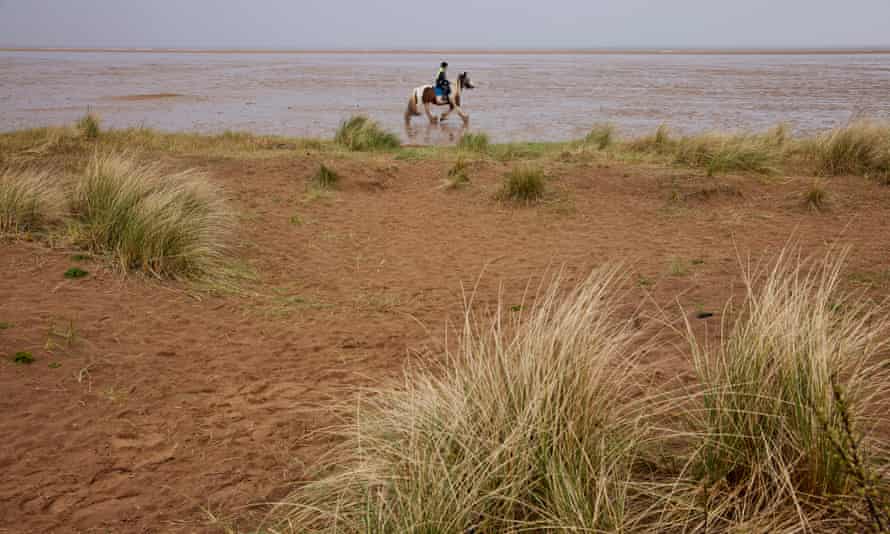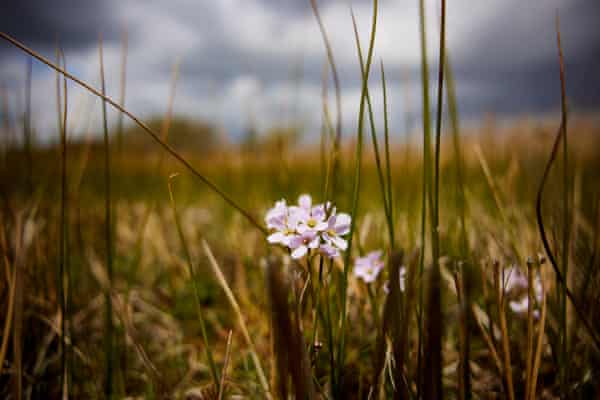Hello hawthorn! GBP10m sand dunes project brings plants back to life
Traditionally, scrub has been allowed to swamp England and Wales’s sand dunes, but now they are being set free

Last modified on Sat 21 Aug 2021 05.31 EDT
A few dark clouds, remnants of the storm that whipped up the North Sea the night before, still hang in the big Lincolnshire skies, above a coastline famed for its kiss-me-quick holiday towns such as Skegness and Mablethorpe. But push on north towards Cleethorpes and the mouth of the Humber, past the caravan parks and imposing sea walls, and the shoreline becomes much wilder, a mix of mud flats and salt marshes, backed by a wide expanse of sand dunes frequented by a few hardy dog walkers.
This is the eastern outpost of Dynamic Dunescapes, a GBP10m project supported by Natural England and conservation groups including Plantlife and the Wildlife Trusts, which aims to bring new life to sand dunes, with a radical approach to their management.
Sand dunes are biodiversity hotspots, a sanctuary for rare animals such as natterjack toads and sand lizards, as well as specialist plants such as the Petalwort and Dune Gentian. But the dunes in Lincolnshire, and much of the rest of the UK, are in a bad way.
Traditional management has put the onus on stabilising sand by allowing vegetation to take hold, a thick underground network of intertwined roots holding things together. It proved a perfect environment for invasive species such as clematis (Traveller’s Joy) and mahonia, which suffocated the dunes under a blanket of thick scrub. In Wales, says Plantlife, 87% of bare sand has been lost, which has led to three dune plants becoming extinct, and a fourth – the rare fen orchid – left on the brink.
Now the thinking has been turned on its head, and sand dunes are being encouraged to move and shift shape, creating the open areas that wildlife needs to thrive. At Lincolnshire’s Saltfleetby-Theddlethorpe national nature reserve, diggers have recently cleared 3.6 hectares (nine acres) of dense scrub that had choked local vegetation such as hawthorn and alder. The diggers unearthed hidden dune slacks, dips between the dunes where ponds form, creating an important habitat for amphibians and insects such as dragonflies. They even found a second world war pillbox, lost beneath the thickets.
The rough, bare ground left behind represents the future of dune management, says the reserve’s enthusiastic manager, Guy Mason. “The idea is that previously smothered plant life will be able to flourish again,” he says, with the weather able to get at the bank of dormant seeds buried just below the surface.

Allowing mature hawthorns to escape the clambering clematis has also provided important nesting sites for turtle doves, the UK’s fastest declining bird species, says Cliff Morrison, who has been volunteering along this stretch of coast for more than 40 years. He remembers the days when they tried tackling the scrub with machetes and billhooks: “Dunes need to be managed by having a little bit of disturbance,” he says. “You need a mosaic of habitats, a real mixture that allows the dunes to move.”

Morrison will also focus his binoculars on an area at the back of the dunes called the Washlands. The River Eau will be allowed to flood this expanse of old arable land later in the year, adding to the patchwork of environments by creating a new wetland for overwintering birds such as wigeon and teal, he says. As if to emphasise the point, as we look out across the fields a rare great white egret lands, towering above a smaller white egret cousin.
To help keep the vegetation in check, a herd of 10 cattle patrols the dunes, with movements controlled by a GPS tracker that allows Mason to fence them in with a virtual boundary. A noise and harmless pulse alerts a cow if it strays too close. With their trampling and grazing, “cows make space for nature”, says Mason, their long tongues pulling up grass to form tussocks, an ideal micro-habitat for invertebrates.
While clearing invasive species is central to restoring dunes on the east coast, different techniques are being deployed in some of the other 34 Dynamic Dunescapes sites in England and Wales, which cover about 7,000 hectares.

For some, the answer is “turf stripping” and removing the layer of rich soil covering the sand to allow pioneering plants to recolonise the dunes, while at Braunton Burrows on the north Devon coast, a process called notching is being used to reinvigorate the landscape. The site covers more than 1,000 hectares, making it the second-largest dune system in Britain, says Plantlife’s Rupert Hawley. In the 1940s, 50% of the burrows were bare sands, but now it’s no more than 15%, and that is putting enormous strain on the flora that makes this area so special – a third of all the UK’s species of vascular plants can be found on this site of special scientific interest (SSSI).
Unlike the east coast, where the wind blows from the land to the sea, here the reverse is true. By cutting V-shaped notches – or pathways – in the fore dunes using diggers, wind blasting inland can move through them, creating “sand rain” that shapes the landscape, ultimately forming new dunes.

This bare sand is crucial for early pioneering species that can’t compete with the scrub on over-stabilised dunes, says Hawley, who hopes to see the likes of wild thyme, the delicate yellow flowers of Lady’s Bedstraw, and the rare water germander, thrive on Braunton again.
Opening up the dunes helps fauna, too, especially cold-blooded sand lizards, which struggle to find suitable sites to soak up the sun’s warming rays if there is too much scrub. Hawley also talks of a “cornucopia of insects” at Braunton, including a solitary bee that nests inside old snail shells, weighing them down with stones to prevent them from blowing away.
But alongside the diggers and the cattle, people also have a role to play in reviving the dunes. One of the core aims of Dynamic Dunescapes, says the engagement manager, Tim Braund, is to encourage local people to volunteer and help monitor the health of the dunes on their doorstep. “We want to slow down that physical journey through the dunes,” he says, encouraging people to see them for what they are, rather than as a strip of wasteland they need to cross before they get to the beach.

The other important role people can play is exploring the dunes, says Braund, who wants to change the perception that people “need to stick to the path”.
“It’s OK to go off the tracks and explore, as long as people are taking notice of local guidance,” he says. “They will help by exposing bits of bare sand or disturbing over-vegetated areas that will benefit the scarce and pioneer plants and animals that we find in dunes.”
Studland, another Dunescapes site in Dorset, is a case in point. Here a rare fungus – sandy Earth Tongue – flourishes at the edges of the footpaths that cross the dunes. “If those people weren’t walking there, that fungus wouldn’t have the habitat to grow in and we’d lose it,” he says. “So there is a role for people exploring the dunes, but in a responsible way.”
Find more age of extinction coverage here, and follow biodiversity reporters Phoebe Weston and Patrick Greenfield on Twitter for all the latest news and features
